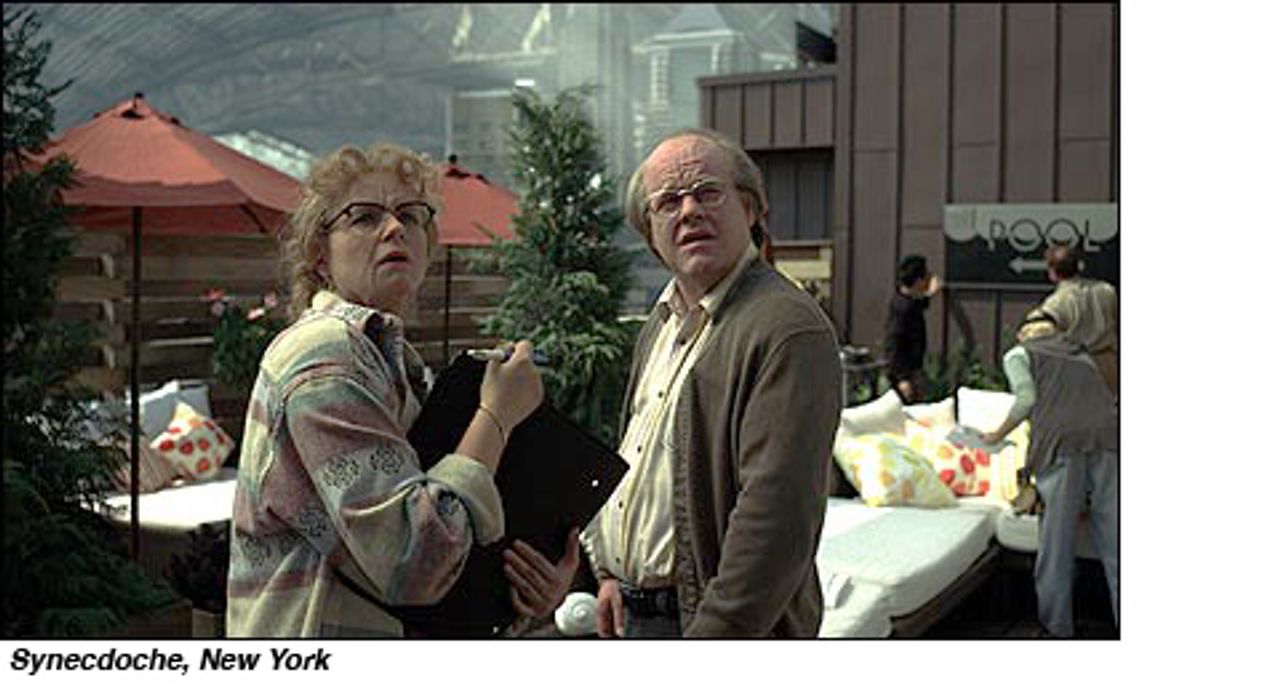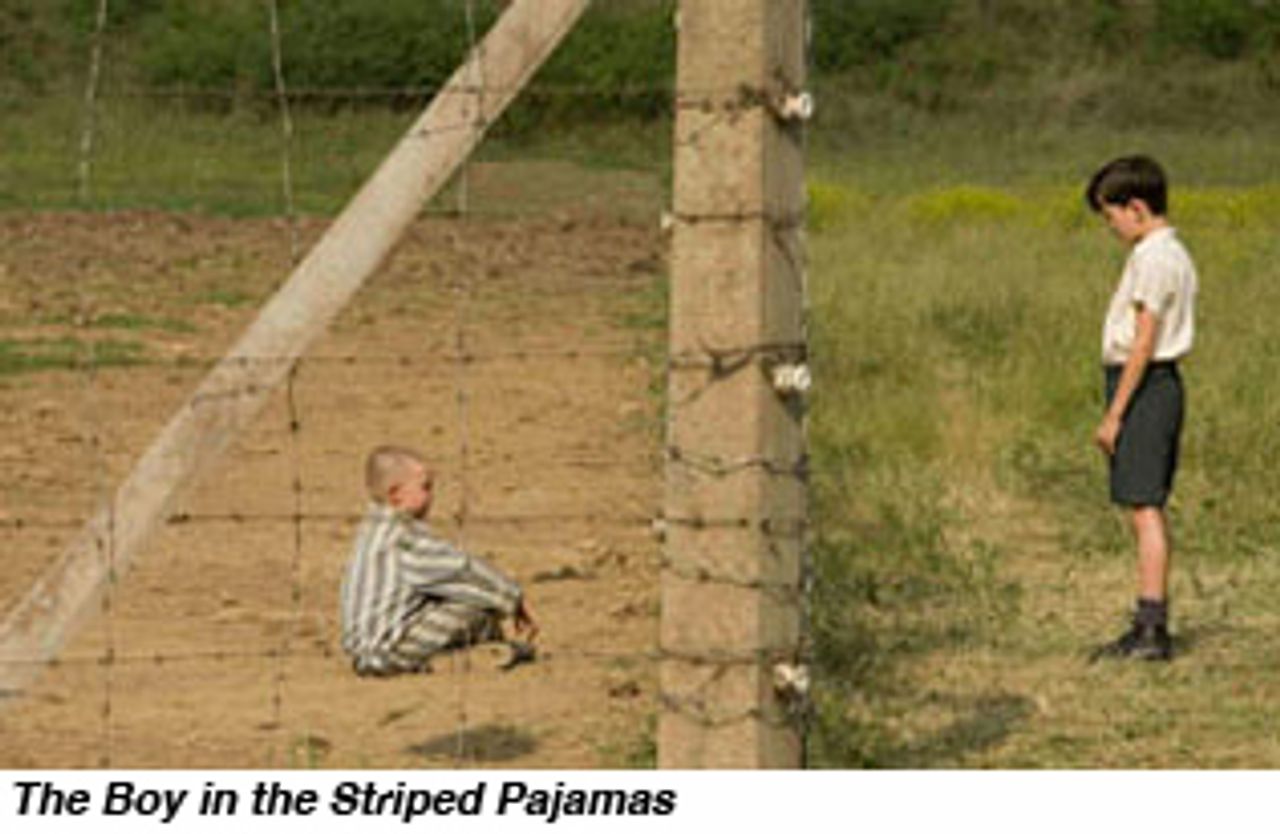Synecdoche, New York, written and directed by Charlie Kaufman; The Boy in the Striped Pajamas, written and directed by Mark Herman, based on the novel by John Boyne
Charlie Kaufman, the screenwriter of Being John Malkovich, Adaptation and Eternal Sunshine of the Spotless Mind, debuts as director of his screenplay, Synecdoche, New York. Kaufman has specialized in the eccentric, the self-referential and the angst-ridden, with varying degrees of success.

The concept of a synecdoche—a figure of speech in which a part stands for the whole, or vice versa—drives the new movie, starting with its play on the name of the town Schenectady, in upstate New York, where its first segments are located.
The film’s “Schenectady” is an alternate reality where personal anxieties and phobias bodily manifest themselves in auto-immune diseases, boils and unpleasant excretions. Such is the case with Caden (Philip Seymour Hoffman), a local theater director, who revises and restages Arthur Miller’s Death of a Salesman to demonstrate that disillusionment with the American Dream is a genetic condition.
In the imaginary town’s day-to-day life, time collapses or passes in an unnatural manner, Saturday morning cartoons are foreboding, and burning houses are sought-after commodities. It is a place where the disquiet of the mind and soul finds a variety of disturbing materializations.
While Caden’s unhappiness and frustration create a physical war-zone inside him, his chilly wife Adele (Catherine Keener) works out her obsessions by painting portraits so minuscule they can only be viewed with magnifying loupes. The couple bring their troubles to a self-help guru (the marvelous Hope Davis) whose only interest is in plugging her best-sellers. (In response to Caden’s comment that he is not ‘getting’ her book, the Davis character responds: “My book is getting you—you’re almost unrecognizable.”)
Soon, however, Adele, with lover and child in tow, abandons her husband (“Everyone is disappointing the more you get to know them”) for the Berlin art scene, where she achieves instant celebrity status.
Caden’s rescue comes when he receives a “genius” grant, and moves to New York City, where he plans to stage ‘brutally honest’ works that “soak in communal juices.” He takes over a giant warehouse and instructs his cast to recreate scenes that celebrate the mundane. At a certain point, the process becomes the reenactment of his own life. The simulacra then give birth to independent realities. Over the next 40 years, the dramas are compounded exponentially and the warehouse becomes a city in its own right.
Caden’s super-sized, chaotic effort, which allows everyone a leading role in his or her own story, is the counterweight to Adele’s concentrated miniatures. There is eventually a family reunion of sorts.
Synecdoche, New York uses black humor to bolster the view that people are suspended between “stasis and anti-stasis,” as they march towards disintegration and death (“They say there was so little left of him, they had to fill his coffin with cotton balls.”). The film’s cinematography is dark and its characters clueless—one suspects not intentionally. In its most effective moments, the movie is an imaginative portrait of urban malaise.
Overall however, Synecdoche fails to grasp the mainspring of a social order it views primarily as a collection of discreet (and dysfunctional) psyches. Kaufman’s redesigned reality never moves forward or develops. It only repeats itself and multiplies.
Postmodernist Jean Baudrillard theorized that a simulacrum was not just a duplicate of the real, but reality on its own. Kaufman adopts this view and uses it as a gimmick to criticize a society that he says is “built on alienation and cynicism and confrontation and all this stuff that hurts people. It closes them. It doesn’t allow them to be open to experience.” But that’s not all that happens to people—this is a bleak and one-sided outlook.
Kaufman’s movie seems to regard death as the only way that change, or rather disruption, takes place. The individual keeps bumbling around, uttering banalities like “the end is built into the beginning,” until something comes along to break the monotony. Along these lines, Kaufman mentions in an interview that a Jungian scholar said that houses are representations of the self. So it is that the film’s burning house has its charm, but it’s also a metaphor at loose ends.
The film’s title implies that as a part its narrative expresses something about the whole. Is this really the case? Is this a reasonable stand-in for America over the period of 40 years? Is this all that’s gone on? Important elements of life are missing—genuine human vitality, social conflict, people learning from events and experiences—in short, existence itself, not simply a depressed synopsis.
Kaufman has written and now directed a number of clever, dark, playful works. They correspond to a certain period (which has now come to an end): of political and cultural stagnation, of a stock market and profit boom for a handful, of postmodern faddishness, of general unseriousness within artistic and especially film circles. He’s accurately depicted some of his own frustration with, and ambivalence about, the time and place he’s been inhabiting.
But, enough now. Enough self-involvement and self-reference. Enough studied and self-conscious ambiguity. If we could offer Kaufman a piece of advice, it would be this: put yourself in your back pocket for a moment, look around at the world and say something substantial about it. It’s possible to do, and there’s no shortage of more interesting subjects …
The Boy in the Striped Pajamas
 Adapted from John Boyne’s novel for children by British director Mark Herman, The Boy in the Striped Pajamas is meant to offer a child’s viewpoint of the Holocaust. It’s also intended to be an adult film. It is not, however, terribly effective as a combination of the two.
Adapted from John Boyne’s novel for children by British director Mark Herman, The Boy in the Striped Pajamas is meant to offer a child’s viewpoint of the Holocaust. It’s also intended to be an adult film. It is not, however, terribly effective as a combination of the two.
To begin with, the movie is an overly literal interpretation of lines from English poet John Betjeman, displayed on the screen during the film’s opening moments: “Childhood is measured out by sounds and smells and sights, before the dark hour of reason grows.”
Eight-year-old Bruno (Asa Butterfield) is the son of a Nazi officer who moves his family from Berlin to take up a new post in the country. As the boy peers out the window of his bedroom, he sees what he thinks is a farm with people whom he thinks are wearing pajamas. He also notices a foul smell coming from the farm’s smokestacks. At first he is left on his own to interpret the meaning of the “sounds and smells and sights.”
As for the adults … his father (David Thewlis), the new commandant of the concentration camp, is on a collision course with his wife (Vera Farmiga) who is uncomfortable with the family’s proximity to the camp. Her efforts focus on keeping Bruno from leaving their guarded compound. But Bruno is lonely and bored and finds his way to the perimeter of the camp, where he meets a gaunt boy his age sitting behind an electrified fence.
Bruno’s “dark hour of reason grows” as his father—and idol—tries to convince him that those people in the camp “are not people at all.”
The film’s faux-naïve perspective is irritating, particularly as the camera lingers too often and too long on Bruno’s blue eyes. The Thewlis character jumps in a flash from Jekyll to Hyde in one of the film’s many abrupt transitions. Further, the movie is weighed down by symmetrical constructs—Bruno and his Jewish counterpart; believers and non-believers in Nazism; children who scamper joyously around Berlin as downtrodden Jewish prisoners are being herded into carts.
Secondary characters lack nuance. Bruno’s tutor is too unsympathetic towards children as the purveyor of Nazi propaganda, and Pavel, a camp inmate assigned to do chores for the commandant’s household, is too kindly in his suffering. (Given the fact that the father/commandant is trying to keep the reality of the camp as far away from his family as possible, is it likely that he would have a half-dead Jewish prisoner in tattered clothing pouring wine at a fancy-dress dinner party?)
In addition, how is it that the two boys can play ball, checkers and wolf down sweets in the corner of a concentration camp?
Despite the film’s various weaknesses, however, it’s hard not to be moved by its ending.
